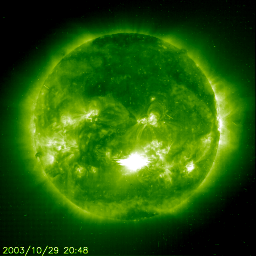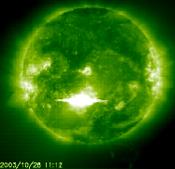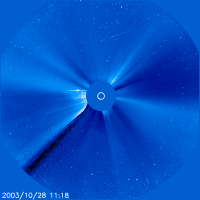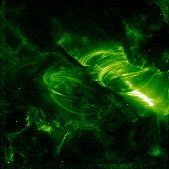Feature
The third most-powerful solar flare ever observed in X-ray wavelengths erupted from Sunspot 486 early October 28, 2003, at approximately 6 a.m. Eastern Standard Time. A coronal mass ejection (CME) directed almost straight at Earth preceded the flare, sending electrically charged gas toward our planet, say NASA and European Space Agency (ESA) scientists. To follow up, the same spot released a large X11 flare Wednesday afternoon and it too is associated with a CME.
To the left, a powerful X11 flare that erupted Wednesday afternoon at 3:48 pm ET, seen with the EIT instrument on SOHO. To the right, Tuesday's record-setting X17.2 flare; both are from Sunspot 486 and Earth-directed, meaning spectacular aurora in areas not usually lucky enough to see them. The Wednesday flare links to a print-resolution version; the Tuesday flare links to a movie of the explosion. Credit: NASA / ESA
This week's flare and CME differ from last week's eruptions both in strength and in speed. This week's flare, category X17.2, is significantly stronger than last week's category X3 and X5 flares. The also-powerful CME, which solar scientists think was accelerated by the eruption of the flare, is headed toward us at 2,000 kilometers per second (1,250 miles per second), nearly five times faster than a normal CME, says Bernhard Fleck, ESA SOHO Project Scientist. SOHO is the SOlar and Heliospheric Observatory satellite, a joint NASA/ESA mission, one instrument with which scientists observed this event.
The flare sent X-rays traveling at the speed of light toward Earth. The X-rays caused a radio storm in the ionosphere during the morning and early afternoon of October 28, 2003, according to NOAA's Space Environment Center (SEC). The CME will not arrive at Earth until approximately noon Wednesday. NOAA uses NASA satellite data to make space weather predictions, much as they use NASA satellite data for Earth weather predictions. The Federal Aviation Administration and Air Force use NOAA SEC information to plan flight paths, as airplanes can experience increased radiation during the arrival of a CME.
SOHO LASCO provides an eclipsed view of the Sun. Here the massive strength of the coronal mass ejection (CME) peppers the camera with particles. The first frame showing the halo of the CME creates a nearly perfect circle around the eclipsed view and is very rare. Click on image for movie. Credit: NASA / ESAThe CME's ionized particles could interfere with power grids and satellite operations depending on the orientation of its magnetic field. If the field points south, the CME particles will interact with Earth's magnetosphere and likely disrupt electrical processes; if it points north, the magnetosphere should mostly shield the Earth from disruptions. Scientists will be unable to determine the orientation until the CME reaches the Advanced Composition Explorer (ACE) satellite in Earth orbit. This won't happen until only 15 minutes before the CME reaches Earth.
NASA and Lockheed Martin's Transition Region and Coronal Explorer (TRACE) satellite also captured images of this solar event. TRACE has a higher spatial and temporal resolution that allows closer views of the eruptions, and scientists can also adjust TRACE's exposure times so that the bright flares don't blind the satellite as it does some other instruments. TRACE can image temperature profiles of solar events and watch as material heated by these eruptions falls back to the solar surface, says Karel Schrijver, Senior Physicist for Lockheed Martin.
TRACE gives scientists a close-up view of the sunspot region 486 thanks to higher spatial and temporal resolution. Click for higher resolution version. Credit: NASA / LMSALThe strongest flare of this solar cycle, in April 2000, a category X20 flare, was not directed at Earth. The Sun's activity varies on an 11-year cycle, with the strongest "solar max" years in 2000-2001. Powerful flares often erupt during the declining phase of the cycle, however, says Fleck.
Coronal mass ejections (CMEs) can be associated with solar flares, though scientists don't know which comes first. The violent discharges of electrically charged gas from the Sun's corona are the largest explosions in the solar system. CMEs launch up to 10 billion tons of ionized gas into space at speeds of one to two million miles an hour. CMEs can cause magnetic storms by interacting with the Earth's magnetic field, distorting its shape and accelerating electrically charged particles trapped within.
The increased solar activity is also having an effect on the International Space Station. Tuesday and Wednesday, the Expedition 8 crew of Commander Mike Foale and Flight Engineer Alexander Kaleri will spend brief periods of time in the aft end of the Zvezda Service Module, which is the location aboard the Station most shielded from higher levels of radiation.
The crew will spend about 20 minutes in Zvezda, twice on each orbit of the Earth for about three orbits, until the station phases out of the high radiation areas (high magnetic latitudes).
Asking the crew to periodically and briefly relocate to Zvezda is not unprecedented. Expeditions 2 & 3 briefly "avoided" high radiation periods in April and November 2001.
Related Links:
SOHO Real-Time Views of the Sun
NASA Goddard Space Flight Center
NASA Goddard Space Flight Center



